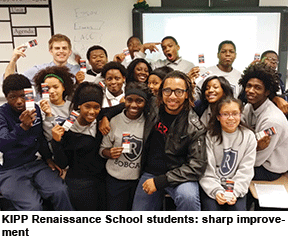 As pupils file into their classroom at Kipp Renaissance, a high school in a battered corner of north-east New Orleans, each one stops to shake the hand of a history teacher. Kipp Renaissance is one of New Orleans’ newer high schools. Since Hurricane Katrina hit in 2005, only six traditional public schools, directly run by the city, remain. Instead 94 percent of pupils now attend charter schools, which are publicly funded but run by independent non-profit organisations such as Kipp (‘Knowledge is Power Programme’).
As pupils file into their classroom at Kipp Renaissance, a high school in a battered corner of north-east New Orleans, each one stops to shake the hand of a history teacher. Kipp Renaissance is one of New Orleans’ newer high schools. Since Hurricane Katrina hit in 2005, only six traditional public schools, directly run by the city, remain. Instead 94 percent of pupils now attend charter schools, which are publicly funded but run by independent non-profit organisations such as Kipp (‘Knowledge is Power Programme’).
Change began in 2003, when Louisiana created a Recovery School District (RSD) to take over and turn around failing schools statewide. Katrina dramatically accelerated the process: the RSD now controls most schools in New Orleans. Since 2008 alone, it has closed about 50 and presided over the opening of an equal number of charters. The district organises admissions and expulsions, and helps allocate school buildings. But staffing, teacher training, transport, catering and much else are left in the hands of schools and the charter chains which run them.
A decade ago, teachers in New Orleans were demoralised. The city’s school district had eight different superintendents in the decade to 2005, none of whom managed to curb corruption or control waste. Affluent whites had fled the system: before Katrina New Orleans was roughly 67 percent black and 28 percent white. Today only 6 percent of public-school pupils are white.
Under the new regime, schools have improved sharply. In 2004, just 16.5 percent of pupils in New Orleans’ schools beat Louisiana’s state average performance score. By the end of the most recent school year, 31.1 percent did, according to the Cowen Institute at Tulane University. High-school graduation rates have risen from 55 percent before Katrina to 73 percent now; drop-out rates have fallen by half. After Katrina, most of New Orleans’ 7,500 unionised teachers were, in effect, fired. Charter schools have hired some back — but they have also hired plenty of new, young ambitious teachers, often straight out of college, who work the long days and extra hours without complaint. The challenge now is whether improvement can be sustained.
One worry is money. Before Katrina, spending per pupil in New Orleans was $7,900 (Rs.5 lakh) per year, about the same as in Louisiana. Last year, the figure was $12,797 — much more than the state average. Federal money, doled out to help rebuild after the hurricane, now pays for repairing almost all the city’s school buildings. But it will not last for ever.
At some point, the city’s overworked teachers may begin to struggle. Some critics say reform has been imposed paternalistically by white reformers on black communities, and so has only limited support. Yet in a vote on December 6, a new tax for school maintenance was easily approved by the city’s voters. They and their children seem to like what they are getting.
(Excerpted and adapted from )